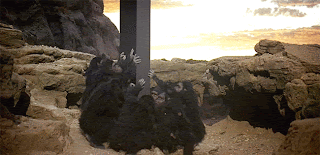 |
| Figure 1: Movie Poster |
2001: Space Odyssey (1968) was a classic science fiction film directed by Stanley Kubrick. The film started off with still images of landscapes that depict the earth in its prehistorical time, about million years ago. In accordance with Darwin’s evolution theory, the film had ape men who were vegetarians but later became carnivores after touching an unknown black object that had the unexplained capability to control their minds. The film then moved along to a scene where living in space was something achievable by the 21st century. The mission of two astronauts and an extremely smart machine called HAL traveling to Jupiter was what brought the story to its other chapter before having spectacular light effects and unsettling ending to wrap up the film.
 |
| Figure 2: Ape Men touching the monolith [Still Image] |
This film has no fixed plot and that has led to different interpretations from different types of audience. George D. DeMet summarized this succinctly when he said, “ "2001" is intensely subjective and cannot be objectively explained, much like one cannot "explain" Beethoven's Ninth or Leonardo's La Gioconda” (DeMet, 1999).
However, the film is propelled forward with the help of its captivating visual aspects. Kubrik’s well-researched idea about space as well as the hiring of spacecraft consultants Frederick Ordway and Harry Lange from NASA made the special effects so seamlessly convincing and brilliant that it left the audience in awe. In a film review written by Almar Haflidason, he points out “There are nevertheless moments of sheer brilliance and it is undoubtedly their stark visual power that lends this piece of cinema its famous visionary qualities.” (Haflidason , 2001)
Technology advances as years go by. New techniques are developed, expanding the endless possibilities to create special effects that can be incorporated into films. Douglas Trumbull, the film’s Visual Effects Supervisor, developed the slit scan method. It was used to create the infinite lights seen during the last part of the movie. The use of this technique is well explained by Renée when he said “The technique is achieved by putting a moveable slide with a slit cut into it between the subject and the photographic plane. The medium used is exposed as the slide moves across one side to the other” (Renée, no date).
 |
| Figure 3: Slit Scan Method |
Apart from the mesmerizing visuals of the film, the sound played an important role in this film. It brings out the emotions from the visuals. In his review on this film, Roger Ebert clearly explains this point when he mentioned “The classical music chosen by Kubrick exists outside the action. It uplifts. It wants to be sublime; it brings a seriousness and transcendence to the visuals" (Ebert, 1997)
In conclusion, this film has not only influence today’s movies like Tron (2010) that uses neon colours and streaks of lights but also the technology world today. Interestingly, the famous electronic device, iPod, by Apple got its name from this movie. Stated in an article from Daily Mail “The credit for naming the iPod goes to copywriter Vinnie Chieco, who drew his inspiration from the line ‘Open the pod bay door, Hal!’ in Stanley Kubrick’s film 2001: A Space Odyssey." (Daily Mail, 2011).
 |
| Figure 4: Tron (2010) |
List of Illustrations:
Figure 1 2001 Space Odyssey (1968) [Poster] at https://blogger.googleusercontent.com/img/b/R29vZ2xl/AVvXsEgyqrg7G6aWtl8oTXxg00PN_vWXSeEyfyPswlVwZOgDno-E-rj-KkipUf7G0WnJJHTp4KyNOT_RJCtEtoph9oK8BHdfH4OnE68W99ZGgluAB2HT8tFxmPisYaOa0h9SGGKH8bVc96SVrW4/s1600/2001-A-Space-Odyssey.jpg accessed on 16 October 2013
Figure 2 Ape Men touching the Monolith [Still Image] at http://theosroundtable.com/wp-content/uploads/2013/02/2001_apes_monolith.gif accessed on 18 October 2013
Figure 3 Slit Scan Method [Still Image] at http://nofilmschool.com/wp-content/uploads/2013/08/Slit-Scan-2001-mechanics-616x345.png accessed on 16 October 2013
Figure 4 Tron (2010) [Still Image] at http://spinoff.comicbookresources.com/wp-content/uploads/2011/07/tron-uprising.jpg accessed on 16 October 2013
List of Bibliography:
Daily Mail UK
2011
How name of decade-old iPod was inspired by Stanley Kubrick movie 2001: A Space Odyssey
http://www.dailymail.co.uk/sciencetech/article-2061143/iPod-inspired-Stanley-Kubrick-movie-2001-A-Space-Odyssey.html
Accessed on 16 October 2013
DeMet, George D.
1999
The Special Effects of "2001: A Space Odyssey"
http://www.palantir.net/2001/meanings/dfx.html
Accessed on 16 October 2013
Ebert, Roger
1997
2001: A Space Odyssey
http://www.rogerebert.com/reviews/great-movie-2001-a-space-odyssey-1968
Accessed on 16 October 2013
Haflidason, Almar
2001
2001: A Space Odyssey (1968)
http://www.bbc.co.uk/films/2000/09/18/2001_review.shtml
Accessed on 16 October 2013
Renée, V
Learn How to Create Stargate Sequences Like in '2001: A Space Odyssey' Using Slit Scan
http://nofilmschool.com/2013/08/learn-how-to-create-slit-screen-sequences/
Accessed on 16 October 2013

Once again, an interesting and thoughtful review :)
ReplyDeleteYou could maybe have used a couple of images from the movie itself, just to support your arguments; maybe the monolith and the apes, for example. It's always good to be able to refer to the images within your text, just as another way of bolstering your discussion.
Apart from that, I haven't really got much else to say - well done!
PS, I have just discovered you Kong review, that slipped through the net somehow - so have a look back at that one too :)
Hi Jackie,
DeleteThank you. I will take note of adding still images from the film to better illustrate my points in my next review :)